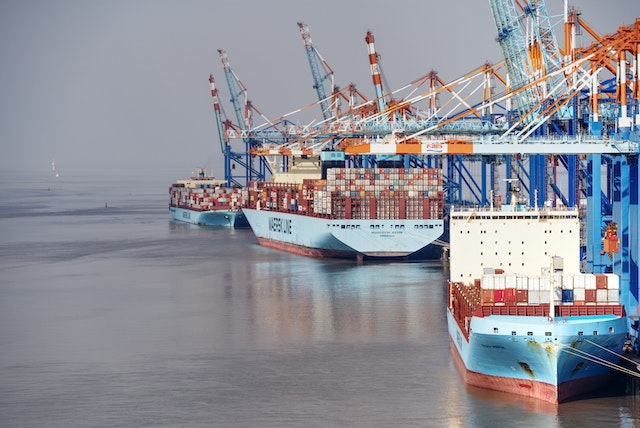
Why don’t shipping containers fall off ships? Well, they do sometimes, but generally they are fastened down with lashing rods.
There are almost 5,500 container ships in the world and they ship over 11 billion tons of cargo around the world every year. The size of the ships has also increased year by year. The largest container ships at the moment (2023) are the MSC Irina and the MSC Loreo. They are 399.9 m long and can carry 24, 346 20 foot containers. MSC stands for Mediterranean Shipping Company. The ships are becoming larger to make transport cheaper. The more you can transport each time, the lower the individual unit cost will become. This is called the economy of scale. There is a limit to how big a container ship can become, though, because there are not many ports in the world that are set up to deal with massive ships. There are also limits on ship size through the Suez Canal, the Singapore Strait, and the Panama Canal. The Panama Canal is being expanded to handle larger ships, but the ships are growing larger faster than the canal can be expanded.
Containers have to be of a standard size so they can be loaded onto any ship. They come in two sizes: 20 feet (6.1 m) and 40 feet (12.2 m). The MSC Irina can carry 24, 346 20 foot containers or 12, 173 40 foot containers. The 40 foot containers have become more popular recently because they can easily be loaded onto a truck and about the legal limit for the roads in most countries. You can pack more in a 40 foot container than you can in two 20 foot containers because you don’t have the wall in the middle. 90% of containers used today are 40 foot containers.
We have all seen pictures of container ships, and it looks very much like the containers are just stacked one on top of the other. So, why don’t they just fall off the ship? How are they fastened on? The first step is to fasten on the bottom containers. It looks like the containers are balanced on the deck, but they actually go down into the cargo hold of the ship. There are deep bays with cell guides, which are strong metal structures that support the containers and keep them balanced. The first layer of containers are lowered into here and fastened to the deck of the hold. They are fastened down using lashing rods. These are long metal bars that are attached diagonally across the front and back of the container. The bottom of the lashing rod is fastened to the floor of the hull and the top of the rod is fastened to the corner of the container. These rods have some elasticity and can absorb the motion of the containers when the ship is at sea.
After the first row has been fastened down with the lashing rods, the rows above are connected to the container below them in succession. All of the containers have an elongated hole at each corner. A twist lock is inserted into the top holes of a container that has been secured and the next container is lowered down so the twist locks go through the holes in the bottom of the container. The twist locks are then twisted with a tool, locking the container in. There are twist locks welded to the floor of the container ship which is another way that the bottom layer of containers are fastened down. Twist locks are also welded onto the beds of the trucks that transport the containers. That’s why it doesn’t look as though the containers are secured to the trucks.
Depending on the height of the stack of containers, the fifth layer is also sometimes secured with lashing rods. There is a bridge to fasten these to at the top of the hull. Sometimes the stacks of containers can be secured to each other, but usually they are independent because this makes it faster and easier to load and unload the ship. Container ships need to be unloaded and then reloaded as fast as possible. Shipping containers can be stacked fairly high, depending on what is in them. They obviously weigh a lot, and all of the weight is on the bottom container, so they can only be stacked as high as that container will allow. The strength of the hull of the ship also comes into play. All of the weight is pressing down in one spot, which means they could rupture the hull if they are stacked too high.
So, shipping containers are attached very securely to each other and to the ship. They can survive very rough seas and the twist locks have a shear strength of 48 tons. However, despite all of this, containers do fall off ships. This is usually down to human error of equipment failure, but it is sometimes caused by incredibly rough seas. It is estimated that at least 650 containers are lost off ships every year. As ships get bigger, the containers and the connectors need to become stronger. And this is what I learned today.
Photo by Pankaj Mishra: https://www.pexels.com/photo/mega-container-ships-11555089/
Sources
https://www.conexwest.com/blog/how-high-can-shipping-containers-be-stacked
https://www.tis-gdv.de/tis_e/containe/sicherung/deck-htm/
https://www.nti.com.au/news-and-resources/blog/why-do-containers-go-overboard-and-who-is-liable
https://www.costamare.com/industry_containerisation
https://www.ics-shipping.org/shipping-fact/shipping-and-world-trade-driving-prosperity/
https://en.wikipedia.org/wiki/Twistlock
https://en.wikipedia.org/wiki/Container_ship
